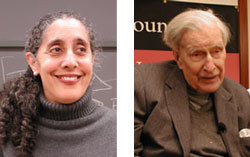
BOSTON (FinalCall.com) – In the wake of President George Bush’s stunning electoral sweep Nov. 2, Democrats, liberals and Blacks are engaged in the wholesale re-examination of their core political beliefs and goals. Progressive, mostly Christian, religious leaders are attempting to broaden the debate about American religious “values” beyond abortion and homosexuality. And economists are adding up the cost that American racial injustice has imposed on its victims.
Many Whites believe that Blacks have already achieved racial equality–45 percent of them, versus 10 percent of Blacks who believe this, explained Michael Dawson, professor of government at Harvard University. Dr. Dawson was one of many experts and intellectuals who painted a grim picture of the prospects of Black social advancement during a recent meeting of the Trotter Group of Black columnists and commentators
Dr. Dawson reported a fundamentally different way of looking at American life by Blacks and Whites. In a poll he conducted before the election, 42 percent of Whites versus 19 percent of Blacks said that “President Bush represents the interests of people like them.”
Still, Census Bureau statistics indicate that one million more people dropped below the poverty line and more became uninsured in the past four years. There are now 42 million uninsured Americans.
What’s even worse, and not likely to improve any time soon, is the wealth gap, according to Dr. Thomas Shapiro, a sociologist at Brandeis University and author of “The Hidden Cost of Being African American.”
After so many decades following the passage of major civil rights legislation, and a highly successful Civil Rights Movement, “why does racial inequality persist at the levels that it does in American society?” Dr. Shapiro asked.
“If we think about those areas where merit and achievement are the currency of advancement, things like education, jobs and income, and in each of those areas we can measure–as a sociologist I can measure–from about the mid-1960s to the current period, we see advancement on the part of African Americans,” he said. The most pronounced advancements are in jobs and occupations.
In the mid-1960s, 750,000 Blacks held jobs that could be called “middle class”–either professional, white collar or technical positions. By the mid-1990s, the corresponding figure is 7.5 million. That’s a ten-fold increase,” Dr. Shapiro pointed out. “That increase takes part through education, through hard-earned degrees, through advancement on the job, and through palpable, visible demonstration of talents and skills that allow people to get to those positions.”
But there’s a down-side, according to Dr. Shapiro, who says such advances are being trumped by widening inequality, specifically in wealth.
“The racial wealth-gap is mostly based on non-merit, meaning inheritance. It is also the result, largely as well, of continuing institutional discrimination in very important areas in American society,” he explains. “The typical African American family has a dime of wealth for every dollar of wealth that the typical White family has in the United States. It’s about $8,000 to $80,000. Those are averages. Those are medians compared to medians.”
However, the traditional indicator for social scientists has been income, not family wealth. Every year the federal government presents measurable data to determine whether the average income of the typical Black family is closer to the average income of the typical White family.
“As we get closer to a dollar-to-a-dollar, there is cause for some celebration in many quarters,” said Dr. Shapiro. “The sociological reality is that since the middle of the 1960s, up until today, the window on how far that income gap–White and Black–has moved is a very narrow window. It moves from about 59 cents on a dollar, as a low, to about 62 cents on a dollar as a high.”
Sadly, he continued, Black people have begun to take for granted the income gap in the range of 60 cents on the dollar as normal.
“Now, a dime on the dollar is a very different proposition than 60 cents on a dollar. Not only does it reveal a very deeply imbedded, structural sense of racial inequality, but it also presents a far more daunting task for us.
“When we ask, ‘how do we get from 60 cents on a dollar to something closer to parity?’ we know what we’re dealing with, and it might seem approachable. But now when we ask, ‘how do we get from a dime on a dollar to something closer to parity?’ it almost seems, on the face of it, like an impossible task.”
“There is a theology and politics of fear that we must counter with the politics of hope,” Rev. Jim Wallis, editor of Sojourners magazine and founder of a progressive evangelical movement, said during a panel entitled, “Is There Too Much God in Politics?”
That fight to define morality could very well lead to new political parties, not just warmed over versions of the two major parties today, according to Harvard law professor Lani Guinier.
“I think we need multiple parties, not just to get somebody elected, but to have a grassroots movement,” she said, adding that movements based on passion instead of quadrennial elections would improve governance.
“We have an ‘electocracy’ not a democracy,” said Prof. Guinier. “You can’t reduce democracy to just elections. We have a country that is democratically illiterate.”
There were others who counseled hope, the most prominent being Dr. John Kenneth Galbraith, the 96-year-old author of “The War on Poverty” and former editor of Fortune magazine. The prominent opponent of the Vietnam War and prolific author is best known for his books “American Capitalism” and “The Affluent Society,” in which he advocated for government spending to fight unemployment and using more of the nation’s wealth for public services and less for private consumption.
“Nothing improves liberal democracy in the United States so much as opposition,” said Dr. Galbraith. “Every mistake (of the opposition) will make liberalism and race relations stronger.”












